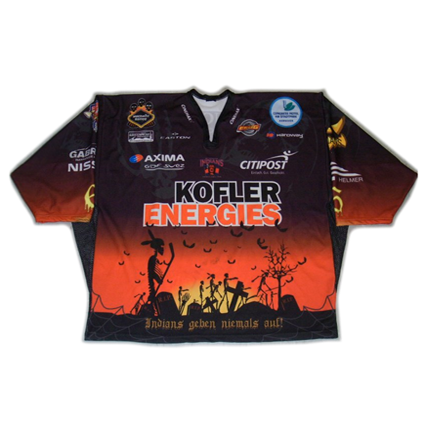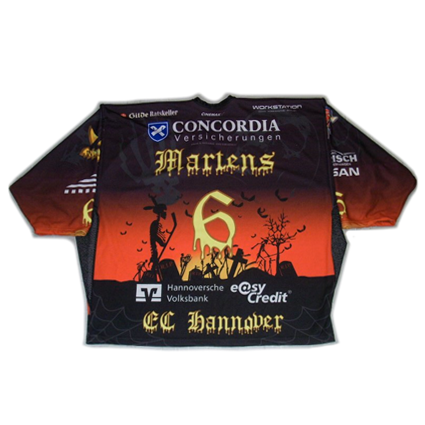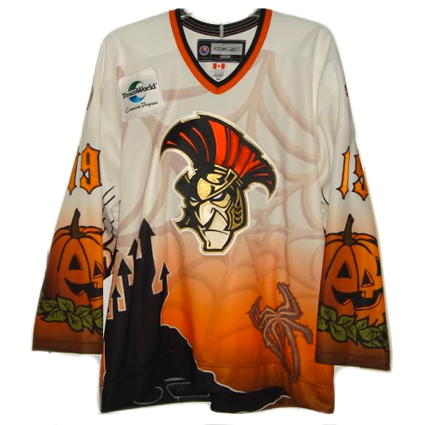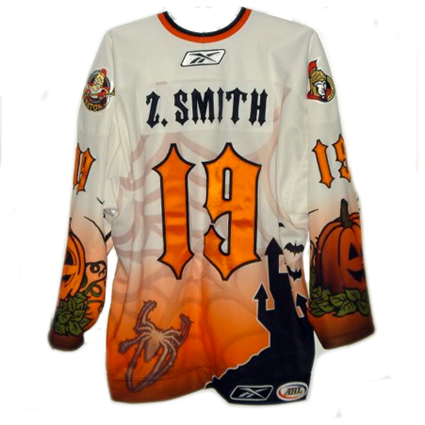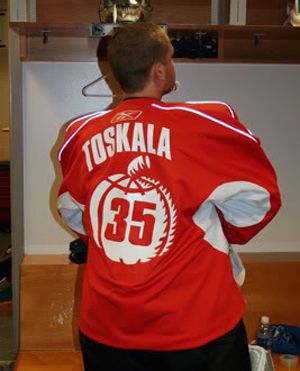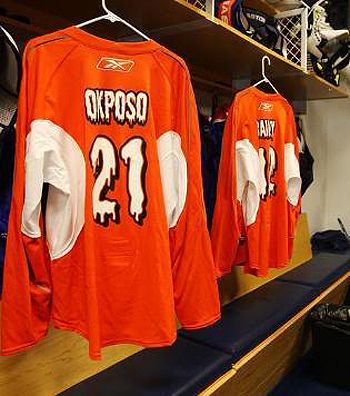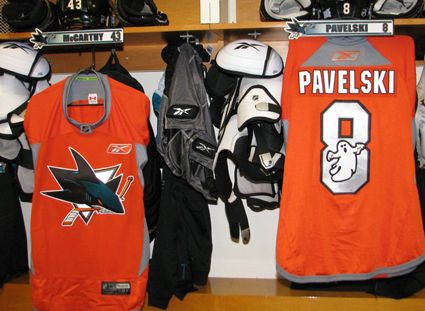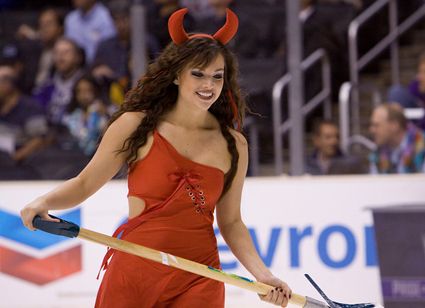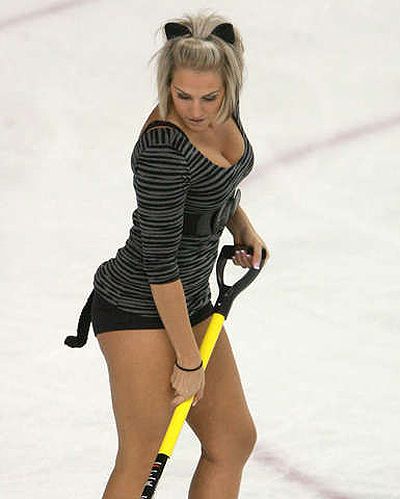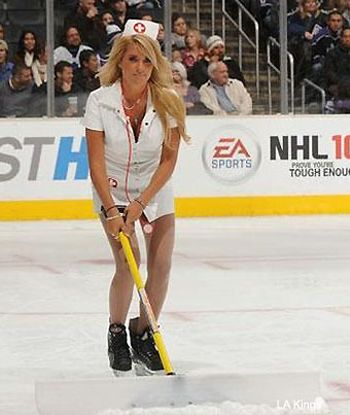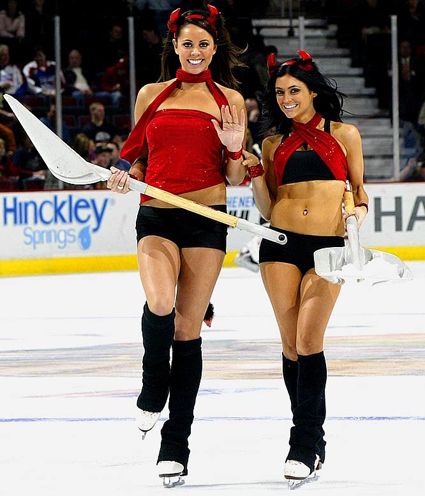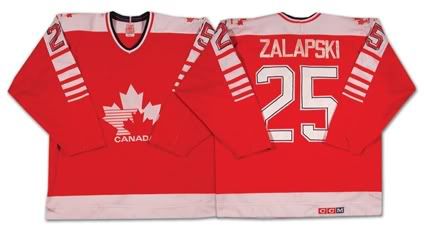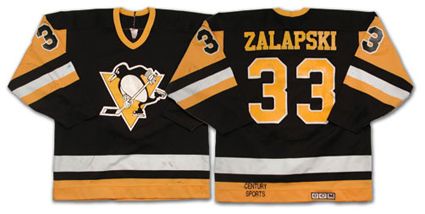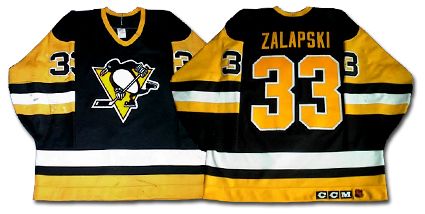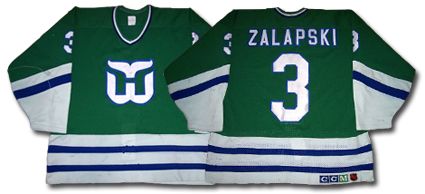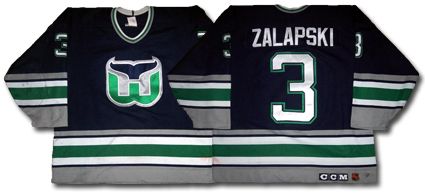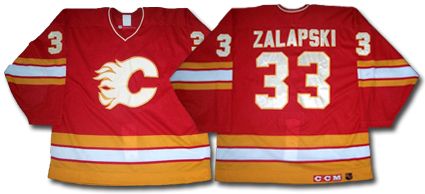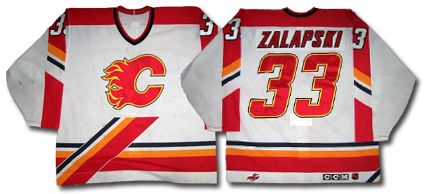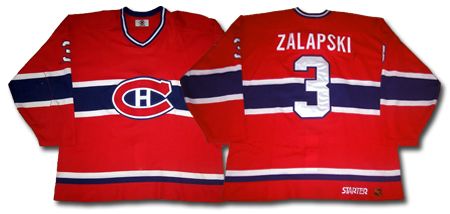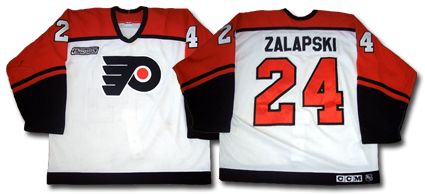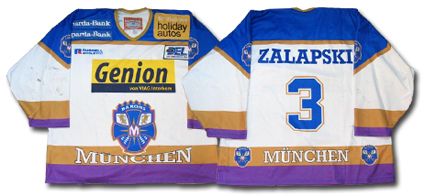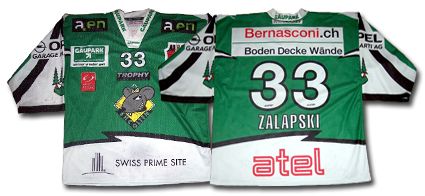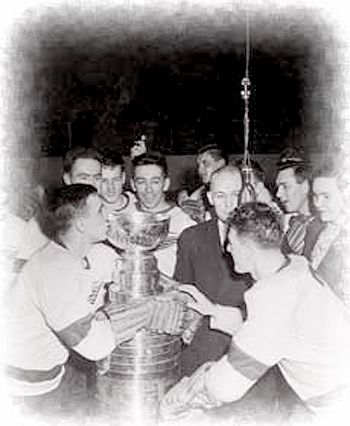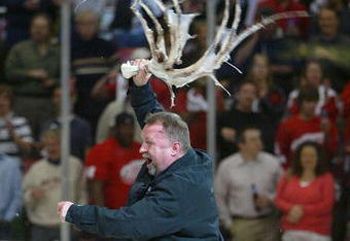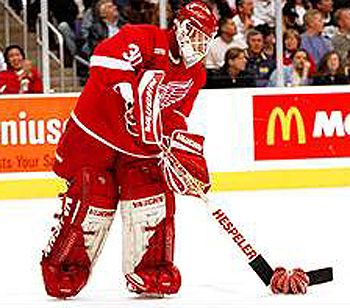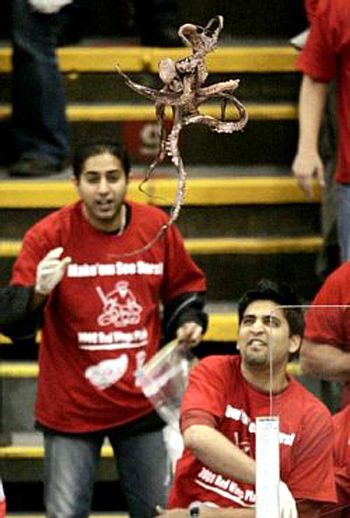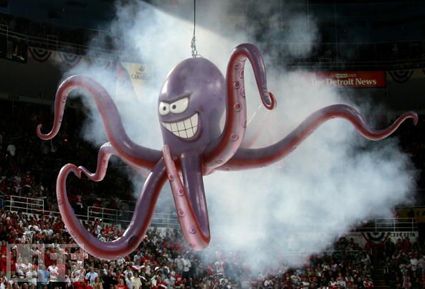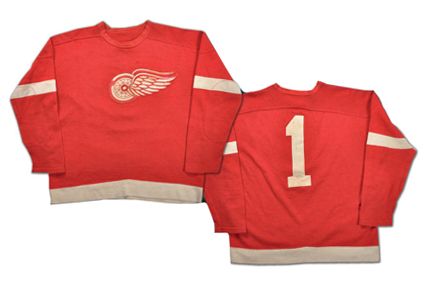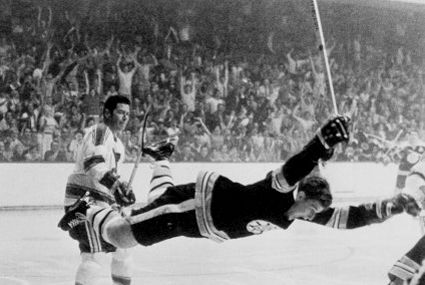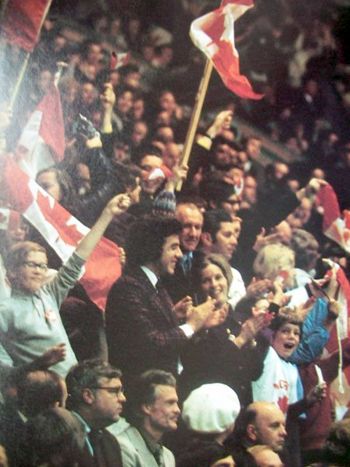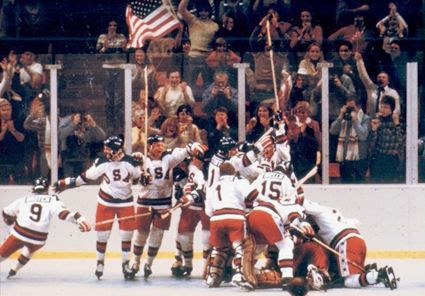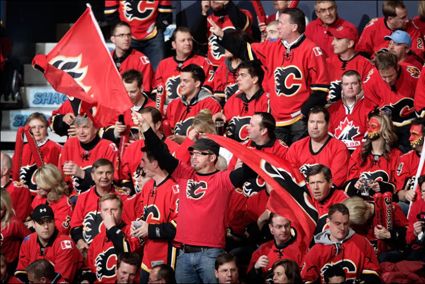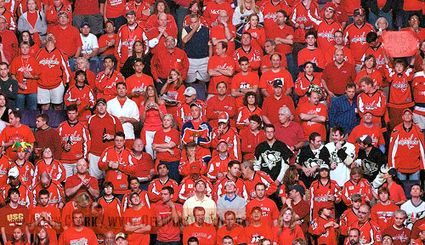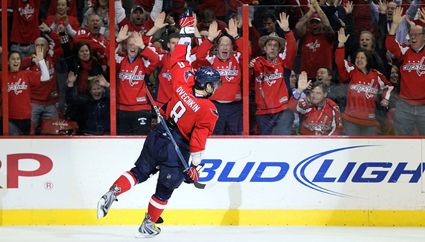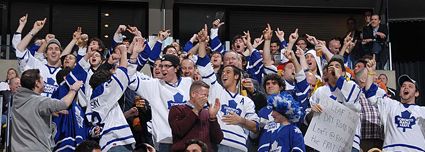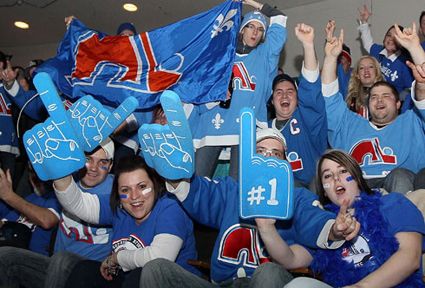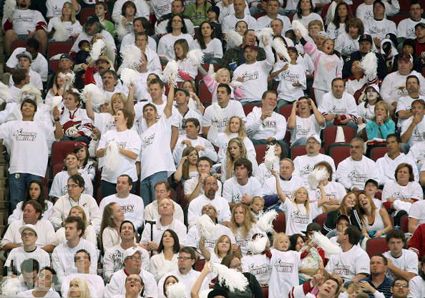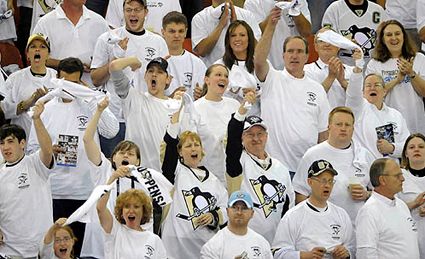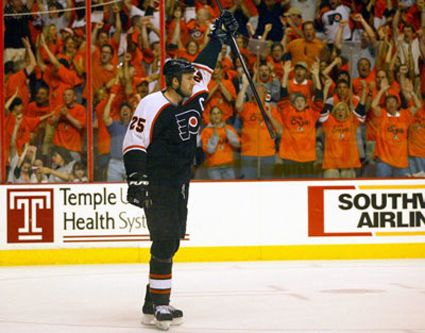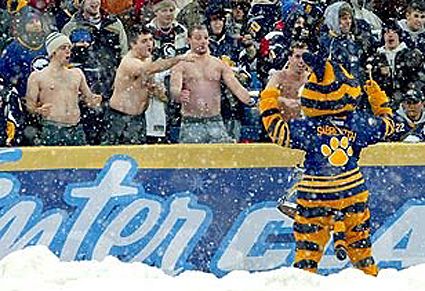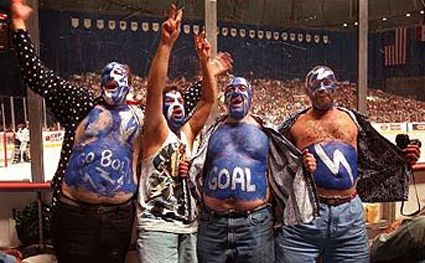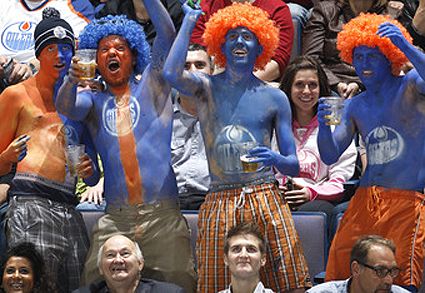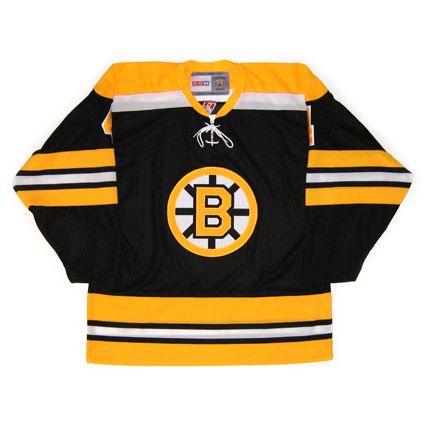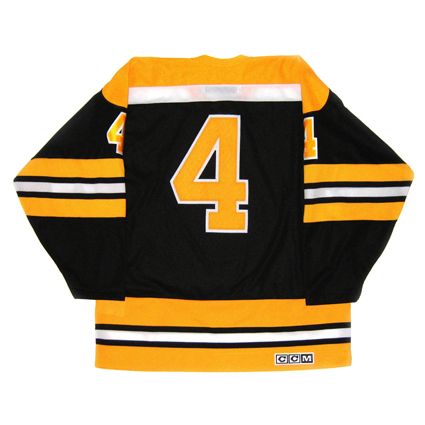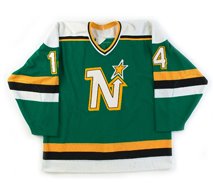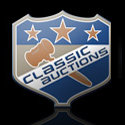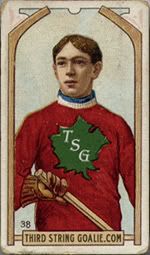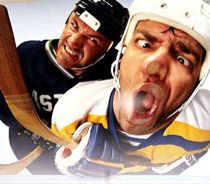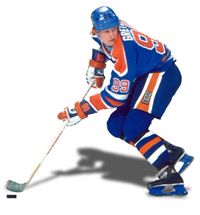Next, then Toronto Maple Leafs general manager Brian Burke and crew perform a Halloween favorite with the help of "The Monster", Jonas Gustavsson.
Showing posts with label humor. Show all posts
Showing posts with label humor. Show all posts
Monday, October 31, 2016
Happy Halloween!
Quite often in the minor leagues teams will create special one-off jerseys for various special occasions such as theme nights, tribute nights or holidays, such as Valentine's Day, New Year's Eve or today's annual observation of Halloween.
The jersey production method of dye-sublimation, which allows for all manner of intricate details to be printed onto jerseys, lends itself perfectly to they eye-catching, or occasionally eye-searing, special occasion jerseys.
Two of the best Halloween jerseys we've ever seen are the efforts by the 2009-10 Hannover Indians of the 2nd Bundesliga, the second level of German professional hockey, in 2009 and the 2008 creation of the Binghamton Senators of the American Hockey League.
This 2009-10 Hannover Indians Halloween jersey, as worn by American Nick Martens, is a downright spooky affair, featuring a series of skeletons, some with feathers on their heads in keeping with the team's nickname, wandering through a graveyard as a large flock of bats circles overhead at sundown. The primary skeleton even sports a hockey stick, showing some thought went into this design and it just wasn't some clip art chosen because it fit the Halloween theme.
Another well chosen element was the choice of the always creepy but fun font "Blood of Dracula" for the player's names and numbers, as well as the team name on the back and the motto on the front of the jersey reads "Indians geben niemals auf!", which translates to "Indians never give up!", which is additionally appropriate for the walking dead.
Fortunately for the jersey designer, the club's main sponsor, Kofler Energies, just happens to have the appropriate orange and black as their corporate colors!
The other favorite jersey on our list is the 2008-09 Binghamton Senators Halloween jersey, as worn by center Zack Smith, who is currently playing for the parent club, the Ottawa Senators of the NHL.
Rather than making the expected black jersey, the Senators opted for a lighter jersey which features many of the usual Halloween icons, such as the jack o' lanterns on the lower sleeves, a spooky castle with circling bats and a large spider on the lower body, whose subtle web covers the majority of the jersey. The look is completed by choosing the font Ironwood, which evokes thoughts of a Gothic dungeon in a spooky castle.
Even the team's main crest doesn't seem out of place, as the angry, cartoonish Senator on the front is rather scary looking and the colors aren't too far off from the color palette of the rest of the package.
While many of the top professional leagues have not embraced the use of special occasion jerseys for games, at times NHL clubs have been known to occasionally create a unique set of jerseys worn in pre-game warmups, like those worn by the San Jose Sharks in 2007 and the New York Islanders in 2009, which were later auctioned off for charity, with John Tavares' jersey raising $1,701.79.
The San Jose Sharks 2007 Halloween themed warmup jersey
The New York Islanders 2009 Halloween themed warmup jersey
The Sharks once again created a special Halloween jersey in 2012 and wore it in pregame warmups. They jerseys were then auctioned off on October 27th and 30th, with one remaining one being sold through NHL Auctions.
The San Jose Sharks 2010 Halloween themed practice jersey
Even if clubs in the NHL choose not to wear special jerseys on this day, it's at least an opportunity for their ice girls to have some fun and dress up in costume.
Today's video segment features the man who did more to make the goalie mask famous than Jacques Plante, Jason Voorhees in a surreal interview with Arsenio Hall.
Next, the Florida Panthers Ice Dancers performance from Halloween 2009. Full credit must be given for doing those high kicks on ice without wiping out. Just how do they do that?
Here's a quick video with some of the best costumes worn to games by NHL fans.
Next, then Toronto Maple Leafs general manager Brian Burke and crew perform a Halloween favorite with the help of "The Monster", Jonas Gustavsson.
Next, then Toronto Maple Leafs general manager Brian Burke and crew perform a Halloween favorite with the help of "The Monster", Jonas Gustavsson.
Finally, a tribute to the Boogeyman, the late Derek Boogaard, on Halloween.
Wednesday, April 22, 2015
The Top Twenty Names in Hockey History
Here is the Top Twenty Names in Hockey History, as chosen by the staff of Third String Goalie.
Don't agree? Send us your favorites in the comments below!
Don't agree? Send us your favorites in the comments below!
Top Twenty Names in Hockey History20. Lou Franceschetti19. Chico Maki18. Branko Radivojevic17. Lucien DeBlois (DEB Low Wah)16. Maxim Afinogenov15. Ilkka Sinisalo14. Tony Twist13. Pekka Rinne12. Frank St. Marseille11. Peter Sidorkiewicz10. Kari Takko9. Bubba Berenzweig8. Sheldon Kannegiesser7. Radek Bonk6. Ron Tugnutt5. Parris Duffus4. Valeri Zelepukin3. Per Djoos (pron: Pear Juice)2. Hakan Loob
And, without a doubt, the greatest name in hockey history, Zarley Zalapski, was born on this date in 1968.
Following two seasons of junior hockey Zalapski played three seasons for the Canadian National Team, then a season long proposition which many players used as a stepping stone to the NHL.
He was drafted fourth overall by the Pittsburgh Penguins in the 1986 NHL Entry Draft and made his NHL debut following the 1988 Olympics in Calgary, Alberta. He would play four seasons for the Penguins, playing a high of 66 games before being traded near the end of the 1990-91 season and just missing out on the Penguins run to the Stanley Cup.
1987-88 Pittsburgh Penguins
1988-89 Pittsburgh Penguins
Notice the changes in the customization in the Penguins jerseys from Zalapski's rookie year to his sophomore season. The name on the back is thinner and without serifs, the number changes font and the sleeve numbers move from the shoulders down to the arms.
The Penguins dealt Zalapski to the Hartford Whalers as part of the Ron Francis trade, a move that saw Zalapski see an increase in playing time and career highs in points as a result. The defenseman's only 20 goal season of his career came in 1991-92 followed by a 65 point campaign the following season while wearing the Whalers green jerseys.
1990-91 Hartford Whalers
Prior to Zalapski's final season in Hartford, they would change to their new modernized jerseys, which featured blue road jerseys rather than the traditional green.
1993-94 Hartford Whalers jersey
Traded once more, Zalapski was on the move, this time north of the border to Calgary to join the Flames. Once in Calgary, he would find his customary #3 already in use by Frantisek Musil and adopt the #33 while skating for the Flames. He would play in five seasons with the Flames, although he would miss all but two games of the 1996-97 season with a knee injury suffered in practice.
1993-94 Calgary Flames
Zalapski played a more defensive role in Calgary, as he would never again approach the offensive numbers he achieved while in Pittsburgh and especially Hartford. Zalapski also was present for yet another uniform change, as the Flames finally moved away from their traditional jerseys, which remained unchanged, save for the crest, even after their relocation from Atlanta.
The bold new sweaters featured the addition of a shot of black, reminiscent of the change the Minnesota North Stars made in 1981, where the restrained use of black added to the jersey, rather than taking over, such as what the North Stars succumed to in 1991. The main feature of the new design was the arresting diagonal multi-stripe on the front of the jerseys, which originated just below the main crest and shot off in the direction of the right hip. These bold jerseys would remain in use for three seasons before becoming dated.
1994-95 Calgary Flames
After five seasons in Calgary, Zalapski was dealt to the Montreal Canadiens in a deal which brought Valeri Bure to Calgary. His stay in Montreal was brief, playing there for only the second half of the 1997-98 season. Now back in his customary #3 Zalapski would have the honor of wearing the classic "bleu, blanc et rouge" sweater of the storied Canadiens.
1997-98 Montreal Canadiens
The 1998-99 season would see Zalapski's first foray into European hockey with an abbreviated season of just 11 games with the ZSC Lions in Zurich, Switzerland. He returned to North America for the 1999-00 season, which included time with the Long Beach Ice Dogs of the IHL for seven games before spending the majority of the season with the Utah Grizzlies, also of the IHL and a return to the NHL with the Philadelphia Flyers for 12 games.
1999-00 Philadelphia Flyers
His time in Philadelphia would be the conclusion of Zalapski's NHL career, which would finish with 637 games played with five teams, 99 goals and 285 assists for 384 points and one All-Star Game appearance in 1993.
He would begin the 2000-01 season with the Houston Aeros of the IHL for nine games before returning to Europe, this time with the Munich Barons of the German DEL.
2000-01 Munich Barons
A new season meant another new country, as the former NHL All-Star found himself with HC Merano of the Italian league for 26 games. Zalapski began to apparently "dabble" in hockey at this point, playing seven games with IF Bjorkloeven Umea in the Swedish second division in 2002-03, no hockey at all in 2003-04 and 11 games with the Kalamazoo Wings in the UHL in 2004-05.
The 2005-06 season saw a total of just 16 split between three clubs, EHC Visp in the Swiss second division, Innsbrucker EV in Austria and SC Rapperswill-Jona Lakers in the Swiss top division. He suited up for just five games in all of 2006-07 with EHC Chur in the Swiss second division leaving behind a trail of lightly used game worn jerseys in his wake!
2007-08 saw a more serious effort with 33 games for EHC Biel-Bienne, still in the Swiss second division and a move to EHC Olten for a 34 game season and one of the more unique team logos in the world of hockey.
Zalapski continues to play 22 years after his NHL debut, proving once more that there is life beyond the NHL, having moved to Lausanne HC in the Swiss second division and are currently involved in a playoff to determine promotion to the Swiss National League A, the top division of Swiss hockey for 2010-11. Lausanne currently leads Bienne three games to two in their best of seven series with Game 6 scheduled for today and Game 7 if needed on Saturday.
Today's video section begins with Zalapski scoring his first NHL goal on March 19, 1988 on a beautiful feed from Mario Lemieux.
Tuesday, April 15, 2014
Detroit's Octopus Throwing Tradition
On this date in 1952, Metro Prystai scored two goals and an assist, while Terry Sawchuk held the Montreal Canadiens scoreless as the Detroit Red Wings captured the Stanley Cup, becoming the first team to ever go undefeated in the playoffs.
But more significant than being awarded a silver chalice as a trinket to note one's success, on this date in 1952 the tradition of hurling a celebratory cephalopod was born in The Motor City.
The brainchild of Pete and Jerry Cusimano, owners of a fish market in Detroit's Eastern Market, the brothers had the bright idea to hurl an octopus onto the ice during the series clinching game to symbolize the eight wins needed to achieve the Stanley Cup during the days of the Original Six - the same number of tentacles possessed by an octopus, making for the perfect synergy in seafood.
"It was a good luck omen," said Cusimano. "The octopus has eight legs and we were going for eight straight."
The bizarre ritual caught on, and Sports Illustrated reported in 1978 when writing about the Red Wings playoff series versus the Atlanta Flames,
"Making their first cup appearance in eight seasons, the Red Wings won their best-of-three preliminary series in two straight games over the favored Atlanta Flames. And as Detroit clinched the upset with a 3-2 victory Thursday night before a record Olympia throng of 16,671, fans hurled no fewer than a dozen live octopuses onto the ice.
As a result, maintenance crews kept scurrying around the rink with pails and shovels and more mannerly fans began to wonder whether there might not be a more seemly way of saluting Detroit's hockey revival.
When the teams moved to Detroit for Thursday's game, the passions of Motown hockey fans were at fever pitch. Scalpers commanded $60 for a pair of $11 tickets, and parking spaces near the Olympia were going for $8. Inside the building, fans bombarded the ice with all those octopuses, as well as two dead chickens, scores of apples and other comestibles. There were moments when the inside of the Olympia was almost as littered as the mean streets outside."
The tradition continues to this day and has made a celebrity of sorts out of Al Sobotka, the Zamboni driver at Joe Louis Arena and the man responsible for retrieving the hurled octopi, which he does with aplomb, twirling the projectile from the depths over his head, winding up the faithful in the process.
During the 1995 playoffs, three dozen octopi were flung onto the ice during the playoffs and the record for a single octopus belongs to Bob Dubisky and Larry Shotwell, who topped their record 38 pounder a year later with a 50 pound monster, which Sobotka proudly displayed on the hood of his Zamboni.
With Detroit's first home game in their quest for the cup scheduled for Sunday, here is a primer on how to get your shot at gooey glory.
After purchasing your Octopus, preferably at the Eastern Market, boil it for 20 minutes on high heat with a little lemon juice and white wine to mask the odor. Not only will this hide the stench of the creature, a boiled octopus will bounce and roll when it hits the ice, rather than landing with a sticky splat that will leave an inky stain on the ice, making for more work for the ice crew.
Another key is the purchase of a desirable aisle seat, allowing a quick response and plenty of elbow room immediately following a goal.
Speaking of a goal, one must know when it is appropriate to toss your octopus. Acceptable opportunities are following the national anthem, following a Red Wings goal or a final game victory, and for heaven's sake, don't aim for anything other than open ice. You don't want to hit any of the game's participants with a disgusting sea creature, or worse, actually hurt them with a launched projectile of between five and thirty pounds.
Cusimano's insights on the proper form for throwing your octopus recommends holding it around the middle of the tentacles with the head hanging down by your knees and then, while keeping your arm straight, swinging it over your head as if throwing a grenade. "That's the only way you're going to get any leverage. You try to throw it like a baseball and you're going to throw your shoulder out," he relates.
Don't grasp it too far down the tentacles however, as they will likely break off in your hand, causing the bulk of the creature to end up randomly deposited on an unsuspecting fan nearby.
Keep in mind, it is against the law to throw anything on the ice during a game, and while no octopus hurler has ever been prosecuted, the Red Wings do try to discourage fans from bringing them into the game. With that in mind, all manner of smuggling techniques have been developed by would-be hurlers. After encapsulating the creature in a zip-lock bag, it can be stuffed stuffed down your shirt or pants, wrapped to your body with plastic wrap or hidden under a hat if size allows.
Once the beast has been launched, getting the stench off your hands with wet-wipes and a slice of lemon will do the trick if gloves weren't worn to begin with.
The Red Wings organization has embraced the tradition, including creating a 35-foot-wide purple octopus which they hang from the rafters of Joe Louis Arena named Al the Octopus, in honor of Sobotka, the Zamboni driver and octopus retriever.
Today's featured jersey is a 1951-52 Detroit Red Wings Terry Sawchuk jersey. The Red Wings jersey is a true classic in the NHL and has remained essentially unchanged since it was introduced back in 1932 when the club changed their name from the Falcons, as they had been known since 1930. The original Detroit red sweaters used red numbers trimmed in white from 1932-33 until a change to single color white numbers in 1937-38, with the next change to the red jerseys being the addition of names forty years later in 1977-78.
In his Stanley Cup Finals debut, Sawchuk won four straight games, including a pair of shutouts in Games 3 and 4 to clinch the cup, bookending the pair of shutouts he had to open the tournament against the Toronto Maple Leafs on his way to an 8-0 record in that year's playoffs.
Today's first video is a look at the Octopus tradition and what it means to Red Wings fans.
In this brief clip, Cody MeLeod of the Colorado Avalanche returns the octopus into the stands!
Finally, another look at the Octopus tradition through the lens of ESPN.
Labels:
Detroit Red Wings,
humor,
Octopus,
odd stories,
Sawchuk Terry
Thursday, February 13, 2014
Fan Apparel - Then and Now
While looking through our copy of "The Hockey Book" by Sports Illustrated, we were struck by the well known photo of Bobby Orr flying through the air in celebration of his overtime Stanley Cup winning goal in the 1970 finals.
In the days before modern marketing, merchandising, product placement, movie tie-ins and endorsements, Orr scores the game winning goal in the 1970 Stanley Cup Finals, and there's not a single ad on the dasher boards or souvenir shirt, cap or jersey to be found.
The text of the book encourages us to "look closely at the photograph" to study the joy on Orr's face. We however, noticed not Orr, but the sea of spectators in the background also leaping for joy vertically, rather than horizontally like Orr. This difference in trajectory brings to light one unescapable fact.
There is not a Bruins logo of any kind visible in the crowd. Not one cap, one t-shirt, sweatshirt and certainly not a single jersey.
Bobby Orr thrills the fans in Boston, 1970
It wasn't much different when national pride was on the line either. The first photo below is from Game 2 of the 1972 Summit Series when the Canadian professionals took on the best of the Soviet Union for the first time, certainly an occasion to show your national pride. Yet not one hint of a Canada hat, shirt or jersey.
Even as the series moved to the Soviet Union, 3,000 Canadians made the trip to Moscow, and while they packed a few flags, only one child in the lower right can be spotted with a t-shirt with a red maple leaf on it. Again, no jerseys or caps anywhere to be found, as even the capitalist North Americans had yet to discover sports merchandising or even simply treating your country as a brand.
Fast forward to the 1980 "Miracle on Ice". Again, look closely at the photograph. This, mind you, was taken at the Olympics during the single most nationalistic game of hockey ever held on the planet. Yet each and every person in the background of this shot bears not a single cap or sweatshirt emblazoned with even a simple "USA", much less a jersey in support of the Boys of Winter.
The fans look as if they dressed for dinner and a movie, not the meeting of "us" against "them" with our nation's pride and Olympic gold on the line. In amongst the winter sweaters and plaid flannel shirts, we're hard pressed to even find anyone who seems to have purposely dressed in either blue or red in support of the Americans, although we wouldn't recommend red for a game against the Soviet Union.
Even as the series moved to the Soviet Union, 3,000 Canadians made the trip to Moscow, and while they packed a few flags, only one child in the lower right can be spotted with a t-shirt with a red maple leaf on it. Again, no jerseys or caps anywhere to be found, as even the capitalist North Americans had yet to discover sports merchandising or even simply treating your country as a brand.
Da, da Canada! Nyet, nyet Soviet!
but still not a single jersey to be found
The fans look as if they dressed for dinner and a movie, not the meeting of "us" against "them" with our nation's pride and Olympic gold on the line. In amongst the winter sweaters and plaid flannel shirts, we're hard pressed to even find anyone who seems to have purposely dressed in either blue or red in support of the Americans, although we wouldn't recommend red for a game against the Soviet Union.
Aside from the flag, you wouldn't know this game
was even held in the United States by looking at the fans
was even held in the United States by looking at the fans
Things started to change following the 1980 Olympics when jackets, t-shirts and sweatshirts began to be more heavily marketed, with much of the initial credit going to the sportswear brand Starter. Companies such as CCM and ProJoy had already began to make replica jerseys specifically for fans to wear to the games. We purchased our first jersey, a Minnesota North Stars jersey, in 1982 or 1983, a nice weight mesh jersey with quality sewn on logos. The problem was, our local sporting goods store used the wrong font for the number on the back, a battle we've been fighting for 30 years now!
The CCM replicas of the late 1980's and early 1990's were light weight, see through efforts that benefitted from having nothing else to compare to. Our 1991-92 NHL 75th anniversary season Turn Back the Clock Detroit, Chicago, Toronto, Boston and New York Rangers jerseys were prime examples of these undersized, semi-transparent replicas - that at the time we were thrilled to own.
It was the later arrival of the CCM 550 line of jerseys brought the quality of those formerly tissue paper thin jerseys up to an entirely new level. Soon, sales really began to take off with the rise in quality and acceptance of team jerseys being worn to games by fans to show their support for their favorite club - and things would never look the same in an NHL arena.
The CCM replicas of the late 1980's and early 1990's were light weight, see through efforts that benefitted from having nothing else to compare to. Our 1991-92 NHL 75th anniversary season Turn Back the Clock Detroit, Chicago, Toronto, Boston and New York Rangers jerseys were prime examples of these undersized, semi-transparent replicas - that at the time we were thrilled to own.
It was the later arrival of the CCM 550 line of jerseys brought the quality of those formerly tissue paper thin jerseys up to an entirely new level. Soon, sales really began to take off with the rise in quality and acceptance of team jerseys being worn to games by fans to show their support for their favorite club - and things would never look the same in an NHL arena.
Now let's take a look at the fans of today. Fans in Calgary, Alberta and known around the league for "The "C" of Red". We believe that no other fans wear a greater percentage of jerseys to games than the fans of the Flames, with red obviously being the color of choice.
The Flames fan's "C" of Red
Hockey is alive and well in Washington, D. C. as the Captials fans "rock the red" for each home game. While the percentage of jerseys are less than those in Calgary, the amount of t-shirts and sweatshirts combined with the jerseys paint the arena with an equal amount of color.
Capitals fans "Rock the Red". See if you can
spot the Penguins fans in attendance.
spot the Penguins fans in attendance.
Alexander Ovechkin leads the chorus of those wearing red
No other fans in the NHL travel as well as those of the Toronto Maple Leafs, as they often arrive en masse in rival buildings sporting their traditional blue and white.
This photo is actually from a game in Boston
Even fans of teams that no longer exist wear the logos and colors of their beloved teams, such as the Minnesota North Stars, Hartford Whalers and Quebec Nordiques. While we don't have the numbers to back up our suspicions, we would not be surprised to learn that more Quebec Nordiques merchandise has been sold since the franchise moved to Denver, Colorado than they did in the 23 seasons they were located in Quebec thanks to the rise of sports merchandising and marketing.
Nordiques fans invade the New York Islanders'
Nassau County Colosseum in December, 2010
Nassau County Colosseum in December, 2010
During the playoffs, tradition in some cities dictates that all fans dress alike, a tradition began in 1985, first Calgary with the "C" of Red (also known as the "Sea of Red") and later in Winnipeg with the "White Out". The tradition has now also found it's way to Pittsburgh and Philadelphia, where the Flyers fans opt for orange as their color of choice.
A "White out" in Phoenix
The Penguins version of the "White out"
The Flyer faithful opt for orange - even if the team didn't!
Finally, it must be noted that while many, many fans in cities all across the NHL buy and wear t-shirts, sweatshirts, hoodies and jerseys of all kinds, not everyone choses to participate,
Shirtless Buffalo Sabres fans at the 2008 Winter Classic
even though those sitting around them sometimes wish they would...
Tampa Bay Lightning fans who
"gotta support the team" opt for body paint instead
"gotta support the team" opt for body paint instead
Oilers fans who are no doubt lubricated also
opt for the "body paint jersey" approach
opt for the "body paint jersey" approach
With clearly plenty of money on the line with the higher prices charged these days for replica and especially retail authentic jerseys, it's disappointing and baffling how Nike in particular cannot seem to be bothered with making the current 2014 Winter Olympic jerseys available in anything other than the most basic choices. A check of River City Sports in Winnipeg and Ice Jerseys in Montreal shows only the three Canada and red Russia jerseys for sale, while one has to really search to even be able to buy the United States jerseys!
Apparently gone are the days when Nike at least made the colored road jerseys from each team for retail with the more popular nations occasionally in the home white, such as in the 1998 and 2002 Olympics when even a Belarus jersey was yours for the asking. The supply began to tighten up in 2006 with the introduction of the new Nike Swift styles and by 2010 if you didn't have your jersey ordered by the time the games started, you considered yourself extremely fortunate to find anything other than a Canada or US jersey, and if by chance you were actually able to track down something as obscure as Norway, that was quite an accomplishment. It appears that this time around, Nike has all but turned it's back on the international jersey market, leaving fans admire their new favorite style on TV, but not in their closet. Any die-hard Los Angeles Kings fan hoping to stand out from the crowd by wearing an Anze Kopitar Slovenia jersey is going to be disappointed.
Today's featured jersey is a 1969-70 Boston Bruins Bobby Orr jersey, the style worn while he was flying through the air like Superman in 1970, which shows how much things have changed in the world of sports merchandising.
At the time Orr scored his famous overtime Stanley Cup winning goal, no such thing existed for fans and collectors to buy, as if there even was such a thing as a memorabilia collector back then.
While jerseys had become available for sale to fans by the late 1980's, things changed in a dramatic way with the arrival of the auction site ebay in 1995. Fans could now list their old jerseys they no longer needed, giving fans and collectors a chance to buy things no longer commercially available.
One trend in particular was the prices being paid for some of the early, lower quality jerseys from defunct clubs such as the Minnesota North Stars, Hartford Whalers and Quebec Nordiques. These original jerseys often reached triple digits for the scarce examples, particularly in the larger sizes, as the older ones ran a size smaller than the current CCM 550's of the day and more of the smallest ones were originally unsold and more readily available now that there was a chance to market them.
Eventually, sensing an opportunity was at hand, CCM introduced "The Vintage Line", reprising long out of production styles which were now up to modern quality standards, as well as making some pre-1980 jersey styles available for the first time ever, such as today's featured Orr Bruins style.
The idea was a hit, as a brand new, available on demand CCM Vintage Line replica jersey was around $80, some 20% less than some of the prices being paid for the semi-transparent, quasi-accurate original releases with the often undersized main crests. There were also authentic model CCM 6100 jerseys, the same as worn on the ice by current NHLers, complete with fight straps for those seeking the most authentic jersey possible, something never before available for the vintage styles.
With the first group of a dozen or so Vintage Line jerseys selling very well, the following year saw a new selection made available, again reprising old styles that were ebay favorites or past jerseys of highly collected players of the day, such as All-Star jerseys worn by Wayne Gretzky and Pittsburgh Penguins Mario Lemieux jerseys from the Penguins back to back Stanley Cup championships in 1991 and 1992. For several years CCM continued to produce a new group of jerseys each year, which were quickly snapped up by those hungry for the older styles which brought back so many great memories, such as your favorite player flying through the air in celebration of winning a Stanley Cup 30 years ago.
Apparently gone are the days when Nike at least made the colored road jerseys from each team for retail with the more popular nations occasionally in the home white, such as in the 1998 and 2002 Olympics when even a Belarus jersey was yours for the asking. The supply began to tighten up in 2006 with the introduction of the new Nike Swift styles and by 2010 if you didn't have your jersey ordered by the time the games started, you considered yourself extremely fortunate to find anything other than a Canada or US jersey, and if by chance you were actually able to track down something as obscure as Norway, that was quite an accomplishment. It appears that this time around, Nike has all but turned it's back on the international jersey market, leaving fans admire their new favorite style on TV, but not in their closet. Any die-hard Los Angeles Kings fan hoping to stand out from the crowd by wearing an Anze Kopitar Slovenia jersey is going to be disappointed.
Today's featured jersey is a 1969-70 Boston Bruins Bobby Orr jersey, the style worn while he was flying through the air like Superman in 1970, which shows how much things have changed in the world of sports merchandising.
At the time Orr scored his famous overtime Stanley Cup winning goal, no such thing existed for fans and collectors to buy, as if there even was such a thing as a memorabilia collector back then.
While jerseys had become available for sale to fans by the late 1980's, things changed in a dramatic way with the arrival of the auction site ebay in 1995. Fans could now list their old jerseys they no longer needed, giving fans and collectors a chance to buy things no longer commercially available.
One trend in particular was the prices being paid for some of the early, lower quality jerseys from defunct clubs such as the Minnesota North Stars, Hartford Whalers and Quebec Nordiques. These original jerseys often reached triple digits for the scarce examples, particularly in the larger sizes, as the older ones ran a size smaller than the current CCM 550's of the day and more of the smallest ones were originally unsold and more readily available now that there was a chance to market them.
Eventually, sensing an opportunity was at hand, CCM introduced "The Vintage Line", reprising long out of production styles which were now up to modern quality standards, as well as making some pre-1980 jersey styles available for the first time ever, such as today's featured Orr Bruins style.
The idea was a hit, as a brand new, available on demand CCM Vintage Line replica jersey was around $80, some 20% less than some of the prices being paid for the semi-transparent, quasi-accurate original releases with the often undersized main crests. There were also authentic model CCM 6100 jerseys, the same as worn on the ice by current NHLers, complete with fight straps for those seeking the most authentic jersey possible, something never before available for the vintage styles.
With the first group of a dozen or so Vintage Line jerseys selling very well, the following year saw a new selection made available, again reprising old styles that were ebay favorites or past jerseys of highly collected players of the day, such as All-Star jerseys worn by Wayne Gretzky and Pittsburgh Penguins Mario Lemieux jerseys from the Penguins back to back Stanley Cup championships in 1991 and 1992. For several years CCM continued to produce a new group of jerseys each year, which were quickly snapped up by those hungry for the older styles which brought back so many great memories, such as your favorite player flying through the air in celebration of winning a Stanley Cup 30 years ago.
Next is the final minute of the 1980 "Miracle on Ice" between the United States and Soviet Union, which, if held today, would generate $1,000,000 in retail sales at the arena.
Here is footage of Calgary's Sea of Red.
White outs in Winnipeg, later Phoenix and more recently Pittsburgh.
Finally, this kid's got it all covered, the jersey and the shirtless/body paint angle.
Labels:
humor,
Jersey History
Wednesday, December 25, 2013
Merry Hockey Christmas! Joyeux Hockey Noël!
Merry Hockey Christmas! Joyeux Hockey Noël!
We hope Santa was good to you this year and brought you the jersey you've been wanting.
We also hope you enjoy our special video collection today.
Don't forget - as our countdown clock in the right hand column shows - tomorrow the World Junior tournament begins, the annual festival hockey featuring "Tomorrow's Stars Today"!
And now...
On to the videos!
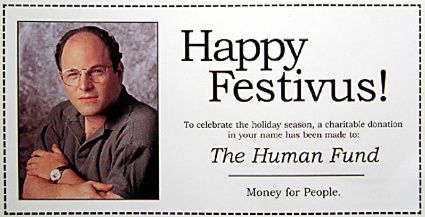
Again, Merry Christmas and Happy Holidays, and for those of you who do not celebrate Christmas, Happy Festivus!

Labels:
humor
Subscribe to:
Posts (Atom)

